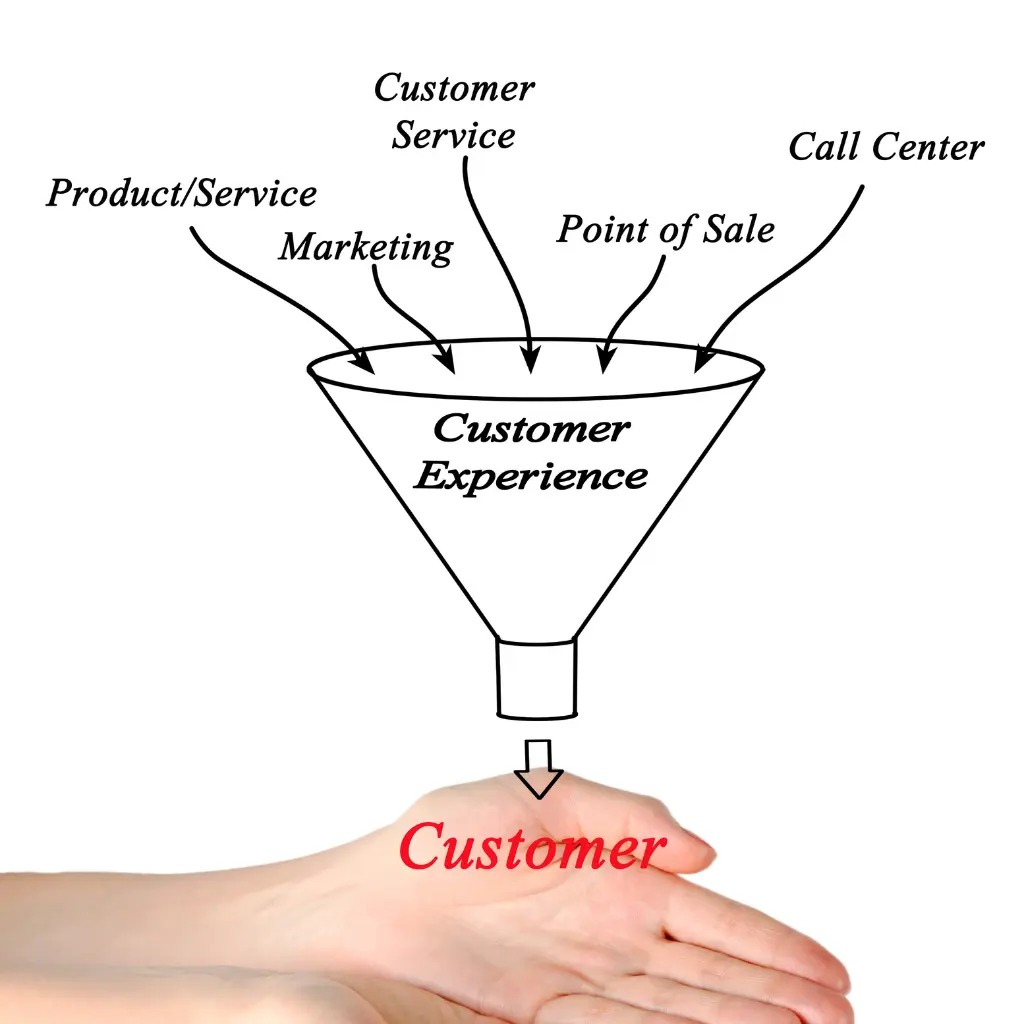
Revolutionizing Retail
AI Tools for Unparalleled Customer Experience and Engagement
This article “AI Tools for Customer Experience and Engagement” explores the challenges and advantages of integrating AI in B2C retail, emphasizing the importance of employee training.
Integrating AI-based customer experience and engagement tools is a pivotal strategy to redefine customer interactions in the dynamic retail landscape.
This comprehensive toolset, comprising personalized product recommendations, virtual shopping assistants, dynamic pricing optimization, predictive customer analytics, and visual search capabilities, promises to elevate customer engagement and drive business success.
As competition intensifies and consumer expectations evolve, incorporating advanced technologies into retail practices becomes crucial.
By navigating these facets strategically, businesses can unlock the potential of AI to create unparalleled customer experiences and secure a lasting position in the ever-evolving retail landscape.
Table of Contents
AI Tool ideas for Customer Experience and Engagement
Personalized Product Recommendations:
- User Behavior Tracking and Analysis: Collect and analyze user interactions, browsing history, and purchase behaviour.
- Integration with Customer Profiles: Connect user data with customer profiles to enhance personalization.
- Real-time Updating: Implement algorithms that update recommendations in real time based on user interactions.
Automated Virtual Shopping Assistants:
- Natural Language Processing (NLP) Capabilities: Develop a conversational AI with NLP for effective communication.
- Product Database Integration: Connect to the product catalogue and inventory to provide accurate information.
- Multi-query Handling: Enable virtual assistants to handle multiple customer queries simultaneously for a seamless experience.
Dynamic Pricing Optimization:
- Real-time Market Data Integration: Incorporate real-time market data and competitor pricing for dynamic pricing strategies.
- Demand Prediction Algorithms: Use machine learning algorithms to predict customer demand and adjust pricing accordingly.
- Rules Engine: Implement a rules engine to define and apply pricing strategies based on various factors.
Predictive Customer Analytics:
- Machine Learning Models: Develop ML models for predicting customer behaviour, preferences, and future purchases.
- CRM Integration: Connect with CRM systems and customer databases to leverage existing customer data.
- Continuous Learning: Implement systems for constant learning and adaptation based on new customer data.
Visual Search and Recognition:
- Advanced Image Recognition: Employ state-of-the-art image recognition algorithms for accurate product identification.
- Catalogue Integration: Connect with the product catalogue and metadata to enhance search accuracy.
- User-Friendly Interface: Develop an intuitive interface to perform image-based searches efficiently.
Business Knowledge Requirements
Understanding Customer Behavior:
A solid grasp of customer behaviour in the retail B2C is crucial to successfully implementing AI Tools for Customer Experience and Engagement. Retailers must comprehend what influences customers to purchase, the products they commonly search for, and the factors that drive repeat purchases.
Product Catalog and Inventory Management:
Familiarity with the products in the retail inventory is essential. This involves understanding how products are categorized and managed within the inventory system. Accurate product data is fundamental for personalized recommendations and virtual shopping assistance.
Customer Relationship Management (CRM):
Knowledge of CRM systems is vital for integrating customer data seamlessly. Retailers should know how customer profiles are structured, the data fields available, and how to leverage this information for predictive analytics. The goal is to enhance customer engagement through personalized interactions.
Market Dynamics and Pricing Strategies:
Understanding market dynamics, including competitor pricing and real-time market data, is necessary. Retailers need to grasp the economic factors influencing pricing decisions. Knowledge of pricing strategies and the ability to create rules for dynamic pricing optimization is crucial for staying competitive.
Image Recognition and Catalog Metadata:
Retailers should understand how images are processed and recognized for visual search and recognition tools. Knowledge of the product catalogue structure, including metadata such as product descriptions and attributes, is essential for accurate image-based search results.
Effective Communication Skills:
Retailers must focus on practical communication skills to deploy automated virtual shopping assistants with NLP capabilities. This involves crafting clear and concise product descriptions, understanding common customer queries, and refining the virtual assistant’s language processing abilities for seamless interactions.
Continuous Learning and Adaptation:
Recognizing the importance of continuous learning in the context of machine learning models is critical. Retailers should appreciate the need for ongoing refinement based on new customer data. This involves staying informed about emerging trends and adapting the AI toolset to evolving customer preferences.
Technical Knowledge Requirements
Programming Languages and Tools:
It’s important to have proficiency in programming languages like Python and frameworks such as TensorFlow or PyTorch. Frameworks provide the necessary tools for efficient implementation of machine learning models. Additionally, knowledge of languages like Java or C# may be beneficial for building robust backend systems required in AI Tools for Customer Experience and Engagement.
Database Management:
Understanding database systems, particularly relational databases like MySQL or NoSQL databases like MongoDB, is essential. Using our AI toolset, we must combine customer profiles, purchase history, and product catalogue information. Knowledge of database query languages, particularly SQL, is considered to be a valuable skill.
Cloud Platforms:
Knowledge of cloud platforms like AWS, Azure, or Google Cloud is necessary for scalable and flexible infrastructure. These platforms provide the computational power and storage needed to handle large datasets, run machine learning models, and ensure real-time updates.
Natural Language Processing (NLP):
For the development of virtual shopping assistants, expertise in NLP is vital. This involves knowledge of libraries like NLTK or spaCy for text processing and understanding. Pre-trained language models like BERT or GPT can help virtual assistants understand the language better. These models are designed to enhance their comprehension abilities.
Image Recognition Algorithms:
The visual search tool is essential to understand image recognition algorithms, including Convolutional Neural Networks (CNNs). Familiarity with image processing libraries such as OpenCV and deep learning frameworks like TensorFlow or PyTorch is necessary for implementing advanced image recognition capabilities.
API Integration:
Retailers must be adept at integrating various APIs to connect the AI toolset with external systems. This includes integrating with CRM systems, market data APIs, and product databases. Knowledge of RESTful APIs and API documentation is crucial for seamless data flow.
Continuous Integration/Continuous Deployment (CI/CD):
Implementing CI/CD pipelines is necessary to deploy the AI toolset’s updates and improvements efficiently. Knowledge of tools like Jenkins, Git, and Docker is essential to automate testing, deployment, and version control processes.
User Interface (UI) Design:
Basic knowledge of UI design principles and front-end technologies (HTML, CSS, JavaScript) benefits the visual search tool and overall user interaction. This ensures a user-friendly interface and a positive customer experience.
Technology Available for AI Tools for Customer Experience and Engagement
Machine Learning Frameworks:
Several powerful machine learning frameworks are available, simplifying the development of predictive analytics and personalized product recommendations. Many machine learning enthusiasts and professionals use TensorFlow and PyTorch to build and train their models. These tools offer pre-built features and extensive community support, making it easier for users to develop their projects. These frameworks facilitate the implementation of algorithms for customer behaviour prediction and dynamic pricing optimization.
Cloud Services:
Cloud service providers like AWS, Azure, and Google Cloud offer powerful platforms for hosting and expanding AI applications. Retailers can leverage cloud services to store and process large datasets, run machine learning models, and ensure real-time updates. Cloud platforms also provide managed database services, easily integrating CRM and customer databases.
Natural Language Processing (NLP) Libraries:
Libraries such as NLTK (Natural Language Toolkit) and spaCy provide pre-built functions for NLP tasks. Additionally, advanced language models like BERT and GPT-3 offer out-of-the-box capabilities for effective communication in virtual shopping assistants. Retailers can integrate these libraries to enhance the conversational abilities of their AI tools.
Image Recognition APIs:
Several image recognition APIs are available, leveraging advanced algorithms for visual search and recognition. Google Vision API, Amazon Rekognition, and Microsoft Azure Computer Vision provide reliable solutions for identifying and classifying objects in images. These APIs streamline the development process, eliminating the need to build image recognition algorithms from scratch.
Database Solutions:
Retailers can efficiently utilize modern database solutions to manage customer profiles, purchase histories, and product catalogues. Relational databases like MySQL and PostgreSQL and NoSQL databases like MongoDB offer scalable and flexible storage options. Additionally, cloud-based databases, such as Amazon DynamoDB, provide managed services for seamless integration.
APIs for Market Data Integration:
APIs from financial and market data providers offer real-time market data, enabling retailers to adjust pricing strategies dynamically. These APIs provide access to competitor pricing, demand predictions, and other market insights. Integration with such APIs enhances the accuracy of pricing decisions in dynamic pricing optimization.
Continuous Integration/Continuous Deployment (CI/CD) Tools:
CI/CD tools like Jenkins, GitLab CI, and CircleCI automate the testing, deployment, and version control processes. These tools facilitate the seamless rollout of updates and improvements to the AI toolset. Retailers can implement CI/CD pipelines to ensure their AI applications’ continuous enhancement and reliability.
Integration needs
API Integrations:
After building the AI toolset, seamless integration with various external systems is crucial for its effectiveness. API integrations play a key role in connecting the retail B2C AI tools with different components of the business ecosystem.
- Customer Relationship Management (CRM) Integration: Connect the AI toolset with CRM systems to access and update customer profiles. This integration ensures personalized recommendations and predictive analytics leverage the most up-to-date customer information.
- Product Database and Inventory Integration: Link the AI tools with the product database and inventory management system to ensure real-time availability and accurate information. This integration enhances the virtual shopping assistant’s ability to provide current product details and availability status.
- Market Data and Competitor Pricing APIs: Integrate with market data and competitor pricing APIs to continuously update pricing strategies. This ensures that dynamic pricing optimization algorithms can access the latest market trends and competitor pricing information.
Continuous Learning and Data Adaptation:
Continuous learning and adaptation are crucial to keep the AI toolset relevant and effective. This involves integrating mechanisms to capture and utilize new data for ongoing improvement.
- Data Feedback Loops: Implement feedback loops to capture user interactions, customer feedback, and transaction data. This information feeds into machine learning models to continuously improve personalized product recommendations and predictive analytics.
- Model Retraining: Set up processes for periodic retraining of machine learning models. As new data becomes available, the models must adapt to changing customer behaviours and market dynamics. Automated retraining ensures the models stay accurate and relevant.
Security and Compliance Measures:
Integrating robust security measures to comply with data protection regulations and safeguard customer data is crucial.
- Data Encryption: Implement encryption protocols to secure data transmission and storage, safeguarding sensitive customer information.
- Access Controls: Set up access controls and permissions to restrict system access based on roles, ensuring only authorized personnel can interact with and modify the AI toolset.
User Interface (UI) Enhancements:
Integrating the AI toolset seamlessly into the user interface is vital for a cohesive and user-friendly experience.
- UI/UX Design Integration: Ensure the AI tools align with the retail platform’s overall UI/UX design. This integration provides customers a seamless and visually appealing experience when interacting with AI features.
- Responsive Design: Optimize the UI for various devices, including desktops, tablets, and mobile phones, to provide a consistent experience across different platforms.
Training Needs for AI Tools for Customer Experience and Engagement
Understanding AI Concepts and Terminology:
To manage AI-based Customer Experience and Engagement tools effectively, existing staff members need training on fundamental AI concepts and terminology. This includes gaining insights into machine learning, natural language processing, and image recognition. A basic understanding of how algorithms work and the implications for customer interactions is crucial.
Tool-specific Training:
Provide in-depth training on the specific tools integrated into the system. Staff should become proficient in using the interface, interpreting analytics, and understanding the functionalities of each tool. For instance, training sessions can focus on navigating the virtual shopping assistant, interpreting dynamic pricing reports, and utilizing predictive analytics for customer engagement.
Data Management and Privacy Training:
Given the sensitivity of customer data, staff must undergo training on data management and privacy regulations. This includes understanding how AI tools store, process, and utilize customer data. Training should emphasize compliance with data protection laws and maintaining customer privacy and security.
Customer Interaction and Communication Skills:
Training should address the nuances of customer interaction through AI tools, particularly with virtual shopping assistants. Staff members should develop practical communication skills to handle customer queries and concerns. This includes understanding how to guide customers through personalized product recommendations and addressing potential challenges conversationally.
Monitoring and Analysis:
Provide training on monitoring and analyzing AI tool performance. Staff members should learn to interpret analytics dashboards, identify patterns in customer behaviour, and make informed decisions based on the insights gained. This training helps staff proactively respond to emerging trends and continuously improve the customer experience.
Troubleshooting and Support:
Equip staff with troubleshooting skills to address any issues with the AI tools. This involves understanding common problems, diagnosing technical issues, and coordinating with technical support teams when necessary. Training on providing adequate customer support within the AI-powered environment is also essential.
Continuous Learning and Adaptation:
Given the dynamic nature of AI technologies, emphasize the importance of continuous learning. Provide ongoing training opportunities to keep staff updated on industry trends, new features, and evolving customer preferences. To effectively use AI tools, teams must be flexible.
Collaboration and Cross-functional Training:
Encourage collaboration and cross-functional training among different departments. Since AI tools impact various aspects of the business, fostering a collaborative environment ensures that staff members from different areas understand how the tools integrate into their workflows.

Arindam Roy
An Automation Consultant with 25+ years of IT Experience
Challenges and Workarounds for AI Tools Implementation
Data Quality and Availability
Challenge:
The effectiveness of AI tools heavily relies on the quality and availability of data. Only complete or accurate data can lead to suboptimal recommendations and predictions.
Workaround:
Implement robust data quality checks, invest in data cleansing tools, and establish processes to regularly update and maintain the integrity of customer profiles, product catalogues, and market data.
Integration Complexity
Challenge:
Integrating AI tools into existing systems can be complicated and time-consuming. It requires coordination across departments and technologies. This process may pose challenges and take some time to complete everything.
Workaround:
Prioritize thorough planning and communication during the integration phase. Utilize standardized APIs and middleware and ensure close collaboration between technical and non-technical teams to streamline the integration process.
User Adoption and Training
Challenge:
Staff and customers may face challenges adapting to AI-based tools, requiring training and change management efforts.
Workaround:
Develop comprehensive training programs for staff, emphasizing the benefits of AI tools. Implement a phased approach to user adoption, gradually introducing new features and providing adequate support to staff and customers during the transition.
Privacy and Ethical Concerns
Challenge:
Using AI in customer engagement raises concerns about data privacy and ethical considerations, particularly in handling sensitive customer information.
Workaround:
Prioritize robust security measures, comply with data protection regulations, and establish transparent communication regarding data usage policies. Implement ethical AI guidelines and regularly audit the AI toolset to ensure responsible and fair practices.
Algorithm Bias and Fairness
Challenge:
AI algorithms may unintentionally exhibit bias, leading to unfair or discriminatory outcomes.
Workaround:
Regularly audit and monitor algorithms for bias. Implement fairness-aware machine learning techniques, diversify training datasets, and involve diverse teams in the development process to mitigate bias and ensure fairness in recommendations and predictions.
Cost and Resource Allocation
Challenge:
Developing and maintaining AI toolsets can be resource-intensive, involving significant infrastructure, talent, and ongoing support costs.
Workaround:
Carefully assess the return on investment and prioritize features based on business impact. Consider leveraging cloud services for scalable infrastructure, exploring open-source tools, and investing in training existing staff to optimize resource allocation.
Customer Trust and Transparency
Challenge:
Customers may need clarification or be apprehensive about interacting with AI tools, leading to a lack of trust in the recommendations or assistance provided.
Workaround:
To promote transparency, we believe in openly communicating how our AI tools work, why we make specific recommendations, and how we handle customer data. Our AI-powered customer experience is designed to provide support whenever you need it, but we also offer human-assisted options to reinforce your trust in us. We can deliver a more trustworthy and reliable customer experience by being transparent and offering human-assisted support.
Adaptability to Market Changes
Challenge:
Markets are dynamic, and customer preferences evolve. AI tools must adapt to these changes to remain effective.
Workaround:
Implement continuous learning mechanisms, regularly update algorithms based on new data, and stay informed about industry trends. Create an environment that encourages innovation and flexibility, allowing for rapid adaptation to changes in the market.
Cost Benefit analysis in AI Tools for Customer Experience and Engagement
Costs:
- Development Costs: Building AI-based Customer Experience and Engagement toolsets involves upfront development costs. Hiring skilled AI developers, data scientists, and engineers can contribute significantly to the expenses.
- Infrastructure Costs: Maintaining a scalable and robust infrastructure, significantly if utilizing cloud services, can add to ongoing costs. Cloud computing resources, storage, and processing power may incur expenses based on usage.
- Integration Costs: Integrating the AI toolset with existing systems, such as CRM databases and market data APIs, may require investment in middleware, APIs, and professional services for a smooth integration process.
- Training Costs: Training existing staff to manage and utilize AI tools effectively is an essential investment. Costs may include training programs, workshops, and resources for upskilling the workforce.
- Security Measures: Implementing stringent security measures to protect customer data incurs costs. This includes encryption technologies, secure access controls, and regular security audits.
Benefits:
- Enhanced Customer Experience: AI-based tools provide personalized product recommendations, real-time assistance through virtual shopping assistants, and a more tailored overall customer experience, increasing customer satisfaction.
- Increased Sales and Revenue: Personalized recommendations and dynamic pricing optimization increase sales by aligning offerings with customer preferences and market demand. This, in turn, positively impacts revenue.
- Operational Efficiency: Automating repetitive tasks, such as customer query handling and dynamic pricing adjustments, enhances operational efficiency. Staff can focus on more strategic and high-value tasks, improving overall productivity.
- Data-Driven Insights: AI tools generate valuable insights through continuous monitoring and analysis. These insights can inform strategic decisions, marketing campaigns, and product development, contributing to a more data-driven approach.
- Competitive Advantage: Implementing AI-based tools provides a competitive edge in the market. The ability to offer personalized experiences, efficient virtual shopping assistance, and dynamic pricing can set a business apart from competitors.
- Adaptability to Market Changes: AI tools with continuous learning capabilities adapt to changing market trends and customer preferences. This adaptability ensures that businesses stay relevant and responsive to evolving market dynamics.
- Improved Customer Engagement: Virtual shopping assistants engage customers in real-time conversations, answering queries and guiding them through purchasing. This leads to improved customer engagement and a stronger connection with the brand.
- Cost Savings in the Long Run: Although initial investments are required, the efficiency gains achieved through AI tools can lead to cost savings over time. Operational efficiency reduced manual intervention, and optimized pricing strategies contribute to long-term financial benefits.
Conclusion
In conclusion, integrating AI Tools for Customer Experience and Engagement in the retail B2C industry presents a transformative landscape with challenges and opportunities. The outlined toolset, encompassing personalized product recommendations, virtual shopping assistants, dynamic pricing optimization, predictive customer analytics, and visual search capabilities, forms a comprehensive suite to elevate customer interactions and drive business success.
While the development and deployment of these tools come with associated costs, the potential benefits are compelling. Thriving in the competitive retail environment requires enhanced customer experiences, increased sales and revenue, operational efficiency, and a data-driven approach. The adaptability of AI tools to market changes ensures a forward-looking strategy, keeping businesses relevant and responsive to evolving customer needs.
It is important to remember that while utilizing data can be helpful, some critical factors need to be considered, such as maintaining the quality of the data, navigating any integration complexities, and addressing ethical concerns. Rigorous data management practices, transparent communication, and bias monitoring are critical to maintaining trust and ensuring responsible AI use. Employee training, both in technical aspects and soft skills, plays a pivotal role in maximizing the potential of AI tools and fostering a culture of innovation within the workforce.
Despite the initial investment, the strategic deployment of AI in customer engagement offers a promising return on investment. Businesses that embrace these tools gain a competitive advantage and position themselves for long-term success through improved customer satisfaction, operational efficiency, and adaptability to ever-changing market dynamics. As we navigate the evolving retail landscape, the synergy between technological innovation and customer-centric strategies emerges as the cornerstone for sustainable growth and unparalleled customer experiences.
Related Articles
- AI Automation Tools in Brick-and-Mortar Retail Store
- AI Tools for Retail B2C Industry
- AI Tools for Customer Feedback and Support in Retail B2C
- AI Tools for Marketing and Advertising in Retail B2C Industry
- AI Tools for Fraud Prevention and Security in Retail B2C
- AI Tools for Sales and Conversion Optimization in the Retail B2C
- AI Tools for Customer Loyalty and Retention in Retail B2C
- AI Tools for Analytics and Reporting in Retail B2C Industry
- AI Tools for Product Management and Innovation in Retail
- AI Tools for Supply Chain Visibility and Optimization in Retail
- AI Tools for Inventory and Supply Chain Management for Retail
- AI in Retail Customer Experience























